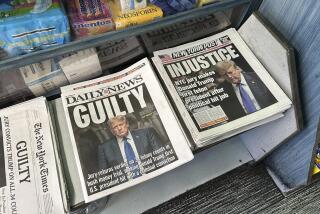The Profit Quest as Journalism’s Bad News
- Share via
An insatiable quest for unreasonably high profits has been slowly sinking the media for years, Washington Post editors Leonard Downie Jr. and Robert G. Kaiser argue in their new book, “The News About the News: American Journalism in Peril” (Knopf).
In chapter after chapter, they detail how pursuit of the dollar and fealty to corporate investors has ownership chain after ownership chain--in print and broadcast journalism--lowering standards. The result has hurt credibility and reduced the chances of doing great work, the authors say, citing reductions of staff and space at print chains such as Knight Ridder and Gannett, the latter a favorite target.
For all the media’s woes, however, Downie and Kaiser see an underlying message of hope. For example, they say the events of Sept. 11 could be a potential salvation if newspapers and broadcast outlets choose to use the public’s reawakened interest in news as an impetus for change.
In a telephone interview, Kaiser said the mixed message of their book partly reflects Downie’s glass-half-empty and his own glass-half-full point of view. Both Kaiser, now an associate editor and senior correspondent, and Downie, the newspaper’s executive editor, have been with the Post since the early 1960s.
“There aren’t many lousy papers with great results, and no great papers with lousy results,” Kaiser said. “My hopefulness is rooted in the thought that, sooner or later, the fact that quality pays and mediocrity doesn’t will catch up with the newsroom manager.
“This could be a pipe dream,” he adds in the same breath.
“The News About the News” is a fast-paced book, its 266 pages written simply and directly, as you would expect from two veteran editors.
It begins with a quick history of news in the United States, running right through the events of Sept. 11, which, the authors note, led the public to buy many more newspapers and watch television news in record numbers.
The authors follow with detailed breakdowns of successful investigations, by the New York Times on the Church of Scientology and by the Post on the high number of fatal shootings by Washington police. They then bring readers through a compelling review of how the Post decided against publishing a story during the 1996 presidential campaign that would have revealed an affair Republican Bob Dole had 30 years earlier.
These stories are intended to show the depth of work and critical decision-making made by the best news organizations. They establish a baseline from which they then compare other newspapers and the broadcast world. The chapters that follow portray the sad state of affairs at most major companies not named the Times or Post. In fact, they say newspapers largely operated under a siege mentality in the ‘80s and ‘90s, owing to the need to satisfy shareholders.
“The proprietors who experimented with the journalistic fashions of the ‘90s,” they write, “usually avoided one obvious avenue to improvement: spending more money on covering the news.”
The examination of the problems of the print world is followed by an enlightening chapter in which Downie and Kaiser coaxed all three network television news anchors--Dan Rather, Tom Brokaw and Peter Jennings--to discuss, by comparing 20-year-old news broadcasts with current ones, the state of their industry.
Brokaw and Jennings remain optimistic about the changes in network news and focus on more people- and consumer-oriented stories. Rather is far more pessimistic, railing against the cost-cutting that drastically slashed the number of foreign correspondents and coverage of world news in favor of more lifestyle stories.
The authors see some good coming out of the growing use of Web sites--more people, they say, are willing to turn to the Internet when news is breaking, which will force broadcasters to work harder on those stories.
As technology continues to march forward, Downie and Kaiser say the leaders of news organizations must recognize that the public wants quality as much as razzle-dazzle. “Our hope is that the industry would begin to understand the huge asset they have and the proper way of caring for it,” Kaiser said.
More to Read
Sign up for our Book Club newsletter
Get the latest news, events and more from the Los Angeles Times Book Club, and help us get L.A. reading and talking.
You may occasionally receive promotional content from the Los Angeles Times.








